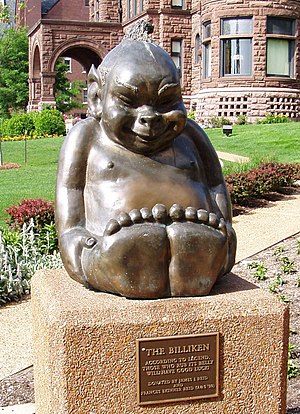
Billiken statue on the campus of Saint Louis University
In designing a new logo for THE Ave, one idea that intrigued me was adapting a college log other than the wild animals, injun warriors, and house pets used to sell college re-professional athletics. On that I found and rather like is the “Billiken!” Frankly it looks a bit like me or my brother *we are both fat and rather slobby!!
I decided, even after some effort with Photoshop, that Billikens would not fit THE Ave, but I think you might enjoy the story:
The Billiken sprang from the height of the “Mind-Cure” craze in the United States at the start of the twentieth century.[5] It represented the “no worry” ideal, and was a huge hit. Variations appeared, such as the “Teddy-Billiken Doll” and the Billycan/Billycant pair (to drive petty problems away). The Billiken helped touch off the doll craze of the era.[5][6]
In its heyday, the Billiken enjoyed worldwide celebrity. In America he became the athletic mascot of Saint Louis University, because the figure was said to resemble coach John R. Bender. The school’s athletic teams remain the Billikens to this day. A bronze statue of the Billiken stands in front of the Chaifetz Arena on the Saint Louis University Campus. A junior version of the Billiken became the mascot of nearby Saint Louis University High School; a stainless steel statue of the Junior Billiken stands adjacent to the Danis Fieldhouse, on the St. Louis University High School Campus. Bud Billiken was a youth-club mascot for the Chicago Defender, and was created in 1923.
At least two Billiken-themed songs were recorded, including “Billiken Rag” and the “Billiken Man Song.” The latter was recorded by Blanche Ring.[7]
The Billiken, as a good luck charm, appears multiple times in the Vivien Leigh and Robert Taylor movie Waterloo Bridge. It is employed as a device that both prompts recollections of the male lead, Robert Taylor, and that links several scenes within the movie as the plot unfolds. Wizard of Oz author L. Frank Baum kept a Billiken doll on his piano.[5]
The Billiken made its Japanese debut in 1908. A statue was installed in the uppermost level of the original Tsutenkaku Tower as it was opened to the public in 1912. When the nearby Luna Park was closed in 1925, the tower’s Billiken statue disappeared. In 1980, a replacement statue made its appearance in a new Tsutenkaku Tower that was built in 1956.